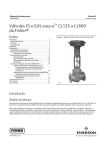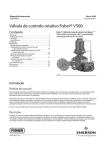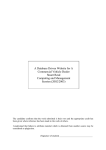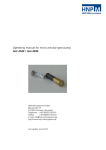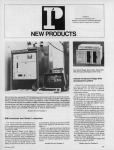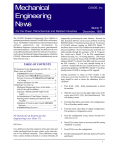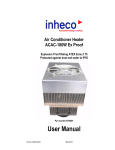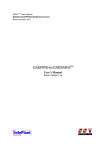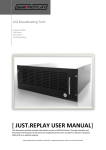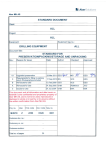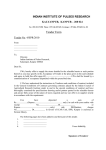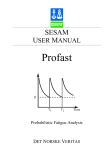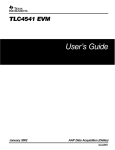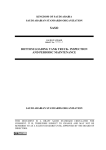Download Mechanical Engineering News
Transcript
Mechanical Engineering News COADE, Inc. For the Power, Petrochemical and Related Industries The COADE Mechanical Engineering News Bulletin is published periodically from the COADE offices in Houston, Texas. The Bulletin is intended to provide information about software applications and development for Mechanical Engineers serving the power, petrochemical, and related industries. Additionally, the Bulletin will serve as the official notification vehicle for software errors discovered in those Mechanical Engineering programs offered by COADE. (Please note, this bulletin is published only two to three times per year.) Volume 18 June, 1994 has also been run on a machine with DOS 6.2 and Doublespace. The software also runs in a DOS box under Windows 3.1. Inside This Issue • • • • Network Versions of all Software Available TANK Program Introduced CAESAR II Memory Reduction CodeCalc Incorporates Rectangular Vessels Table Of Contents PC Hardware for the Engineering User (Part 18) ..... 1 What’s New at COADE TANK - COADE Introduces New Software ......... 3 Changes for CAESAR II Version 3.21 ................ 4 Changes for CodeCalc Version 5.3 ...................... 4 Seminar Schedules for 1994 .................................. 5 Technology You Can Use Flange Rigidity Calculations Added to CAESAR II and CodeCalc ...... ...................... 5 The Influence of Corrosion on Flange Design ...... 6 An Introduction to Rectangular Vessel Computations ................................................... 7 Establishing Time History Input - An Example .... 8 Watching out for Virus Infections ....................... 13 Modifying Printer Configurations ....................... 13 CAESAR II Specifications ................................. 14 TANK Specifications .......................................... 15 PC Hardware & Systems for the Engineering User (Part 18) Occasionally COADE receives inquiries about the compatibility of specific hardware and operating systems with our products. At the present time, all of our software products will run on Intel compatible CPUs from the 80386 up to and including the Pentium. (CodeCalc, PROVESSEL, TANK also run on the 8088, and 80286.) All software runs on DOS versions 3.1 up to and including 6.2. Our software Network Versions In order to address user requests for network versions of COADE Software products, COADE has implemented a new External Software Lock (ESL) from a second supplier. The new ESLs provide transparent access to both a local installation and a network installation. Additionally, all COADE software products will continue to support the current ESL. Through the support for three different ESL configurations, COADE products should be able to provide the flexibility required to address any DOS/PC installation. According to the vendor, the network protocols supported by this new ESL are: NETBIOS, IPX, and IPXNOSAP. This should allow operation under Novell, DLink, Lantastic, Netware, Lan Manager, and 3 COM networks. (Please note, COADE has implemented a Novell 3.11 network. We have no experience with any of the other systems listed here.) All of our software products have been modified to facilitate installation and usage on a network. The distribution files have been segregate into three directories; \Program, \Program\System, and \Program\Examples (where \Program is the user- specified installation directory). This organization of files enables “read only” access to the program directory while still allowing user access to public, system wide files. In addition, the Installation program and the File Manager have both been modified to address discontiguous network drives. 1 COADE Mechanical Engineering News DOS, and Things That Go "Bump" in the Night Some users have experienced a problem installing COADE software; the program files are not extracted from the compressed distribution modules. To understand how and why this happens one must study the operation of the command interpreter, COMMAND.COM. When the system is booted, DOS loads COMMAND.COM in three sections, in three different locations in system memory. The first section, the resident portion of COMMAND.COM, is loaded as low as possible, just after the internal DOS tables and interrupt vectors. The resident portion of COMMAND.COM maintains several internal DOS variables and processes interrupt requests. The second portion of COMMAND.COM contains the installation and setup code. This portion is only used during the boot process. Once the system is up and running, the memory used by this part of COMMAND.COM is returned to the system. The third part of COMMAND.COM is the transient portion. This portion is used to contain additional data tables and to process internal commands. When an external command is issued (the user requests a program to be run), the memory used by this transient portion of COMMAND.COM is released to the system. When the user program terminates, the resident portion of COMMAND.COM must reload the transient portion from disk. This is where the potential for a problem lies; the system must be able to find COMMAND.COM on disk. The system attempts to reload COMMAND.COM from disk using the COMSPEC environment variable. The COMSPEC variable defines where on disk COMMAND.COM is located. If COMSPEC points to a floppy drive, and the diskette has been changed, the attempt fails. If COMSPEC points to a different (or altered) version of COMMAND.COM, the attempt fails. (For safety, many users copy COMMAND.COM from the root directory to the \DOS directory, just so a backup exists. If DOS is upgraded, the \DOS copy of COMMAND.COM must be upgraded manually to avoid potential version mismatches, especially if COMSPEC points to \DOS. During the reload of the transient portion, COMMAND.COM performs a “checksum” to insure what gets loaded is the same as what was loaded during the initial boot process.) During the installation of COADE software, the process of extracting the program files from the compressed distribution files is performed by a “batch file”. Invoking a batch file requires reloading COMMAND.COM. Therefore, booting the system from a floppy drive, or multiple versions of COMMAND.COM, will cause this batch process to fail. This leaves the compressed distribution files in the installation 2 June, 1994 directory. To complete the installation, the user must manually run each (self-extracting) compressed program. Once all of the files have been extracted, the compressed distribution files can be deleted, and the configuration program run. Bottom line, if the PC was booted from a floppy disk, the installation procedure must be completed "by hand". In a related matter, users may have noticed that sometimes the DOS command line editing facility (the F1, F2, and F3 keys) does not work, i.e. the system has apparently lost the command string. This is actually a function of the last program run on the system. Unfortunately, DOS stores the command string in the transient portion at the top of memory. When this area is released to the system to run an external program, the buffer containing the command string may be overwritten. If this happens, the F1, F2, and F3 editing keys have nothing to work with. ESL Notes The current (green) ESLs have been in use by COADE since early 1990. Some users who have newer (faster) computers, or computers with substandard parallel ports have experienced problems accessing these ESLs. Typically the error values returned are 5003 and 5001. The Summer 1994 release of all of our products will contain code to specifically attempt to work around the 5003 error. However, the ESL vendor has also suggested the following environment settings as possible solutions. These environment settings should be tried individually from the DOS command line. If a 5003 or 5001 problem is resolved, the command should be placed permanently in the system AUTOEXEC.BAT file. These environment commands are: SET SSI_ACT=l,m,n The values of “l”, “m”, and “n” can vary, but typical values are 30, 30, and 40. These values are used instead of the automatic timing constants determined by the software. SET SSI_MEM=OLD This setting indicates to the software that slower ESL memory access should be used. Contact the COADE Sales Department for Network Upgrade Pricing. COADE Mechanical Engineering News TANK - COADE Introduces a New API-650/653 Program In March of 1994, COADE released the first version of TANK, a program for the design and analysis of oil storage tanks according to the rules of API-650 (9th edition) and API-653 (1st edition). One of the major goals of TANK is to provide an easy, obvious interface for the user. To this end, TANK incorporates the best interface features of CAESAR II and CodeCalc - installation verification and configuration, context sensitive help for input cells and menu options, custom units, error checking and diagnostics, scrolling input/output screens, and of course, Technical Support. The sidebar lists the major technical capabilities of TANK Version 1.00. Anyone interested in additional information on TANK should contact the COADE Sales staff. Demonstration disks (the actual program minus the computation engine) are available on request. Version 1.10 of TANK is nearing completion and incorporates the network addressing modifications discussed previously. TANK Version 1.1 will be shipped to all users of Version 1.0. In addition, the following enhancements have been added to the software: June, 1994 TANK API 650/653 Engineering Software Design & Analysis of Oil Storage Tanks Using the Latest API 650 & 653 Codes Thickness design per variable point, one foot and Appendix A methods • Computations according to API-650 Section 3.11 for Wind Overturning Stability have been added. • Anchorage design/analysis per API-650 Appendix E Section E.6 has been added. • Automatic generation of nozzle material modulus and expansion coefficient according to API-650 Appendix Table P-1 added. Internal pressure per Appendix F For API-653 analysis, an additional output table for “Retiring Thicknesses” and “Remaining Corrosion Allowances” has been added. Nozzle Flexibilities & allowable loads • • An option is available to perform a corroded hydrotest case for API-653 evaluations. • A new loader provides diagnostic capabilities from the Main Menu. • • A batch stream processor has been added to enable the processing of multiple jobs. The input and output modules support a “pop-up” calculator for on-screen computations. The calculator supports the basic four math operations, trigonometric functions, squares, and square roots. Allowed fluid height Seismic requirements of Appendix E Wind girder requirements Shell settlement evaluation according to API 653 Appendix B Built-in Appendix P curves Built-in materials data base Context sensitive Help & integrated error checking User-defined units Introductory price of $895 US Call for more information today! 3 COADE Mechanical Engineering News June, 1994 Changes for CAESAR II Version 3.21 • An additional spring hanger manufacturer has been added – Carpenter & Paterson, from the UK. The enhancements and changes for CAESAR II Version 3.21 are also nearing completion. A partial list of these changes is shown below. • Uniform Building Code (UBC) earthquake spectra added. • Additional changes to the input piping preprocessor include: • • • • Most of the CAESAR II executable modules have been converted from Microsoft 16 bit FORTRAN to WATCOM 32 bit FORTRAN. This has reduced the low DOS RAM requirements of the program from 577k to 475k. The software now supports an ESL from a new vendor. This provides CAESAR II with full networking abilities. The program first checks for a local ESL (from either vendor), then for a network ESL. The SIF scratch-pad from the Miscellaneous processor (Option C of the Main Menu) has been incorporated into the piping preprocessor. This processor includes all of the supported piping codes (not just B31.1 and B31.3 as in Version 3.20) and all of the fittings. Additionally, any changes made to the scratch-pad data can optionally be transferred directly to the main CAESAR II data spreadsheets. The piping code addenda have been reviewed and any necessary changes made to the software. The addenda include revisions for: ASCE #7, B31.1, B31.8, ASME NC, and ASME ND. • The B31.5 piping code has been added. • The API-617 and NEMA-SM23 reports have been overhauled so that the code compliance when using non-English units systems is consistent. • The new Flange Rigidity factor from ASME Section VIII has been added (see accompanying article for details). - problem size is now dependent on the amount of free extended memory - the old limit of 400 elements is now upwards of 8,000 elements. - graphics menus automatically turned off for hard copies - optional node number display for supports, anchors, hangers, and nozzles in graphics - function key map shown on main spreadsheet - auxiliary input spreadsheets support on-line help CAESAR II Version 3.21 will be shipped to all "current" CAESAR II purchases and leases. Changes for CodeCalc Version 5.3 The CodeCalc program has also been revised. The new CodeCalc, Version 5.3 includes many enhancements and should ship by June 1994. The major changes to the program are listed below. • The A-93 Code Addenda are included. • A new module is available to perform analysis/design for rectangular vessels. • The User’s Manual has been completely revised. COADE BBS The COADE Bulletin Board is a service provided to our users to facilitate the timely transfer of data and program files. The COADE BBS can be accessed by dailing 713-890-7286 and completing the registration information. The files available for download are segregated by application. Note, patches for a specific program version should only be used with that version. 4 COADE Mechanical Engineering News • Wind and Earthquake loads are automatically generated by the Leg&Lug module. • The new Flange Rigidity factor from Appendix S has been added (see accompanying article for details). Bolt circle/weld leg interference checks are performed in the Flange module. • • The software now supports an ESL from a new vendor. This provides CodeCalc with full networking abilities. The program first checks for a local ESL (from either vendor), then for a network ESL. • A completely new configuration program is available. • An error processor is included to explain “fatal” software conditions. • The input spreadsheets have been revised to operate in a “scrolling” mode, as opposed to the “page down/ page up” mode. • The input modules support a “pop-up” calculator for on-screen computations. The calculator supports the basic four math operations, trigonometric functions, squares, and square roots. CodeCalc Version 5.3 will be shipped to all CodeCalc users who purchase the next Update/Support/Maintenance Year which begins June 1, 1994. June, 1994 Flange Rigidity Calculations Added to CAESAR II and CodeCalc The January 1994 editions of Section VIII, Division 1 and Division 2 incorporate a new appendix for the determination of a “flange rigidity” factor. This factor is a parameter which indicates the tendency of the flange to leak. As acknowledged by the Code, flanges which have been designed based on allowable stress limits alone may not be sufficiently rigid to control leakage. The flange rigidity factor is a parameter which attempts to indicate the potential for a leakage problem to occur. The flange rigidity factor (J) is computed from one of three equations, depending on the type of flange, and should be less than 1.0. Should the computed rigidity factor exceed 1.0, the Code suggests increasing the flange thickness and recalculating all flange particulars. The various flange rigidity factor equations are listed below. Except for the Kl and KL parameters, all terms are as defined in ASME Section VIII, Appendix 2. Integral and optional-type flanges: (Optional flanges may be calculated as either loose or integral.) J= F52.14 M V I G HLEg h K J K 0 2 0 0 1 Loose-type flanges with hubs: COADE Seminar Schedule J= The following seminars have been scheduled for the remainder of 1994, at the COADE Houston offices. F52.14 M V I G HLEg h K J K 0 2 0 0 L L Loose-type flanges without hubs: Piping September 21-23 September 26-30 Introduction to Pipe Stress Statics & Dynamics November 7-11 Statics & Dynamics J= F 109. 4 M I G K K J K HEt 1naf 0 3 L The Summer 1994 release of CAESAR II, and CodeCalc will include the computation of the flange rigidity factor. Pressure Vessel October 17-19 ASME Sect VIII 5 COADE Mechanical Engineering News The Influence of Corrosion on Flange Design The ASME Code Section VIII Division 1 Appendix 2 addresses the design of flanges for custom applications such as those types used on pressure vessels and heat exchangers. Appendix 2 defines several types or styles of flanges. They are, Weld Neck Flanges, Slip on Flanges, Ring Flanges and Reverse Geometry Weld Neck Flanges. Some of these styles of flange can be sub classified as being a loose or possibly an optional type of flange. Our brief study will observe what happens when corrosion is considered to be acting on the flange face and when it is not acting on the flange face. A flange can be thought of as a set of discrete radial beams which are being loaded by the effects of pressure and bolting. Pressure and bolting produce loads which try to split the flanges apart. Once the loads are known, the distances over which they act can be determined, moments can be computed and ultimately stresses can be calculated. In the course of the stress computation the Code computes various flange stress factors such as Alpha, Beta, Gamma, Delta and Lambda. All of these stress factors are a direct function of the flange thickness except Gamma, which is a function of the flange ID and OD. The question now becomes, “When we compute the stress factors, should the value of the flange thickness involve the corrosion allowance?”. The Code does give us some guidance in this matter. In paragraph UG-16 (e), the Code clearly states “The dimensional symbols used in all design formulas throughout this Division represent dimensions in the corroded condition.” Thus it would appear that one should use (t-ca) in the design formulas for the stress factors per the Code. However, in the Forward to the ASME Code, there is some leeway given to designers to account for good engineering judgement. It is the design philosophy of some that the flange stress factors should not be corroded. The reasoning is that the flange face does not become corroded. Some say the fluid contacting the flange face does not have sufficient velocity to corrode the flange face and they believe corroding the stress factors leads to a more costly flange. Some design engineers say that when a unit is torn down the flange face remains perfectly smooth and uncorroded. There is certainly a great deal of wisdom in experience. Unfortunately, the design philosophy on this subject is not consistent between fabrication facilities and engineering design firms. Periodically there is some discussion as to who is right. Fortunately CodeCalc asks a simple question “Do you wish to Include Corrosion in the Flange Thickness Calculations”. An appropriate Yes or No answer here causes CodeCalc to either corrode the flange factors or not. To get 6 June, 1994 a better picture of what actually happens, two weld neck flanges were analyzed. One with the corrosion question answered as Yes and one as No. All other input for these jobs were identical. The input and the results are shown below. One should note that the flange ID and the hub dimensions are corroded regardless of the answer to this question. INPUT VALUES, FLANGE NUMBER 4, Description: NO CORROSION Description of Flange Geometry (Type) Integral Weld Neck Description of Flange Analysis Analysis Only Design Pressure P 220.00 psig Design Temperature 330.00 F Corrosion Allowance FCOR .1250 in. Use Corrosion Allowance in Thickness Calcs. No Flange Inside Diameter Flange Outside Diameter Flange Thickness Thickness of Hub at Small End Thickness of Hub at Large End Length of Hub B A T G0 G1 HL 19.2500 24.3750 1.5625 .3750 .6250 1.2500 in. in. in. in. in. in. Flange Material Flange Allowable Stress At Temperature Flange Allowable Stress At Ambient SFO SFA SA105-F 17500.00 psi 17500.00 psi Bolt Material Bolt Allowable Stress At Temperature Bolt Allowable Stress At Ambient SBO SBA SA193-B7-1 25000.00 psi 25000.00 psi Diameter of Bolt Circle Nominal Bolt Diameter Type of Threads Number of Bolts C 22.7500 in. DB .7500 in. TEMA Thread Series 24 Flange Face Outside Diameter Flange Face Inside Diameter Flange Facing Sketch FOD FID Gasket Gasket Gasket Gasket GOD GID M Y Outside Diameter Inside Diameter Factor, m, Design Seating Stress Column for Gasket Seating Gasket Thickness Length of Partition Gasket 21.2500 in. 19.5000 in. 1, Code Sketch 1a 21.1250 20.3750 3.7500 7600.00 in. in. psi 2, Code Column II .1250 in. 20.7500 in. FLANGE ANALYSIS, FLANGE NUMBER 4, Description: NO CORROSION ASME Code, Section VIII, Division 1, 1992, , Appendix 2, A-93 Flange Factors for Integral Flange: Factor F per 2-7.2 Factor V per 2-7.3 Factor f per 2-7.6 Factors from Figure 2-7.1 T = 1.818 Y = 8.830 d = 6.354in ^3 Stress Factors BETA = 1.766 DELTA = .600 Stress Computation Results: OPERATING Actual Allowed Longitudinal Hub 17739. 26250. Radial Flange 3165. 17500. Tangential Flange 8787. 17500. Maximum Average 13263. 17500. Bolting 13490. 25000. K U Z e ALPHA GAMMA LAMBDA = = = = = = = .811 .211 1.013 1.250 9.703 4.556 .367in^-1 1.574 .866 1.466 GASKET SEATING Actual Allowed 21525. 26250. 3841. 17500. 10662. 17500. 16094. 17500. 16896. 25000. Estimated M.A.W.P. MIN( OPE., SEATING ) Estimated Finished Weight of Flange Estimated Unfinished Weight of Forging APP. S Flange Rigidity Factor for Seating Case APP. S Flange Rigidity Factor for Operating Case 290.3 88.6 139.8 .347 .426 psi psi psi psi psi psig lb. lb. COADE Mechanical Engineering News June, 1994 The following results can be produced by answering Yes to the Include Corrosion question. All other input values are identical to those above. Note the differences in the flange stress factors when comparing these results. RESULTS, FLANGE NUMBER 5, Description: W/CORROSION Flange Factors for Integral Flange: Factor F per 2-7.2 Factor V per 2-7.3 Factor f per 2-7.6 Factors from Figure 2-7.1 K T = 1.818 U Y = 8.830 Z d = 6.354 in^3 e Stress Factors ALPHA BETA = 1.704 GAMMA DELTA = .467 LAMBDA Stress Computation Results: OPERATING Actual Allowed Longitudinal Hub 19884. 26250. Radial Flange 4047. 17500. Tangential Flange 8984. 17500. Maximum Average 14434. 17500. Bolting 13490. 25000. = = = = = = = .811 .211 1.013 1.250 9.703 4.556 .367 in^-1 1.528 .840 1.308 GASKET SEATING Actual Allowed 24127. 26250. 4910. 17500. 10901. 17500. 17514. 17500. 16896. 25000. Estimated M.A.W.P. MIN( OPE., SEATING ) Estimated Finished Weight of Flange Estimated Unfinished Weight of Forging APP. S Flange Rigidity Factor for Seating Case APP. S Flange Rigidity Factor for Operating Case 266.7 88.6 139.8 .389 .477 psi psi psi psi psi psig lb. lb. An Introduction to Rectangular Vessel Computations Included in the June release of CodeCalc version 5.3 is the Rectangular Vessel module. This module performs both stress calculations and maximum allowable working pressure calculations per Section VIII, Division I, Appendix 13. At present, the Rectangular Vessel module encompasses all of the analysis types included in Appendix 13 with two exceptions: vessel type 13-2(a)- 6, and vessels subjected to external pressure. The vessel type 13-2(a)-6 is a modified version of vessel type 13-2(a)-5 and will be included in future updates of CodeCalc. Likewise, future updates will include the external pressure calculations discussed in Section 13-14. The stress calculations involve membrane, bending, and total stresses. For each of the three types of stress calculations a maximum allowable working pressure is computed. The only exception is in the analysis of vessel type 13-2(c)(See Figure 1). Note the stresses in this abbreviated report. The stresses in the case of NO CORROSION are nicely within Code allowables. The W/CORROSION case however has exceeded the Code allowable in the Maximum Average category. Thus we can see that this geometry has failed when we corrode the stress factors. Additionally, all of the flange stresses were higher in the corroded case, than in the “non corroded” case. The process of flange design is simplified considerably when using a computerized program such as CodeCalc. This easily allows the designer to consider both the corroded and uncorroded condition. The magnitude of the difference between these runs indicates the significance of this decision. When combined with experience, knowledge of the chemical process and its effect on the unit, the designer should be able to make the appropriate decision in this matter. Figure 1 For this circular cross section vessel, a single diametral plate separates the vessel into two compartments. If the vessel is being analyzed with differing pressures in the two compartments, then the M.A.W.P. calculation for the vessel will not be performed. The reason for the absence of this calculation can be seen from reviewing the bending stress calculation for the shell section (Section 13-13, Equation 8). L M M F I c M 3 R2 G 2t1 J M Sb = P 1G + P 1 − P2 J G 3I1 M t3 Hπππ2 − 8 J K M M 6+ M t1 N 2 a O P P P P 3 P P P P Q f FI HK 7 COADE Mechanical Engineering News June, 1994 Because this equation considers both the 1st compartment pressure and the difference in the 1st and 2nd compartment pressure, there is no single M.A.W.P. that can be computed. The maximum value of one of the two pressures will be dependent on the input value of the other pressure. In addition to vessel type 13-2(a)-6 and vessels with external pressure mentioned above, vessels 13-2(a)-9 and 13-2(a)-10 are not directly addressed. These two vessels have stay bars or stay plates separating the vessel into nonuniform dimensions. In order to analyze these vessels in CodeCalc, the second method described in Section 13-9(f) is used. The following discussion addresses each of the possible cases. Figure 3 In the event that the vessel has a single stay plate separating the vessel into two compartments (See Figure 2), the analysis is performed per Section 13-9(b). This analysis assumes that the compartments have equal dimensions, as in Figure 2 (a). If the vessel has dissimilar compartments, as in Figure 2(b), the method of analysis requires that the vessel be analyzed as if the compartments are of the same size, with the dimensions equal to that of the largest compartment. In the case of Figure 2(b), the height dimension h2, would be entered for the longside height. By inspecting the code stress equations for these stayed vessels, it can be seen that the greater the dimension h is, the greater the code stress is. Because of this direct relationship, by using the maximum dimensions throughout, the stress analysis will be a conservative analysis. The stresses in the smaller compartments will actually be much lower than the calculated values. Establishing Time History Input An Example Figure 2 The second case is that of a vessel with multiple compartments (Figure 3). The analysis for this type of vessel is described in Section 13-9(c). The analysis is carried forth as if the vessel had three similar compartments (Figure 3(a)). In the event that the vessel has three, or more, compartments of dissimilar dimensions, the maximum height dimension is entered as the long-side height. In the case of Figure 3(b), the height h3 would be used for the analysis. This method is indifferent to the true number of compartments. 8 Volume 17 (December 1993) of Mechanical Engineering News (M.E.N.) described the basics of modal time history analysis. This capability was first released in CAESAR II Version 3.2. That first article on time history analysis approached the subject through a textbook example — dynamic response of a simple cantilever beam to a sudden, constant load. The intent was to introduce this new capability and develop user confidence through an intuitive analogy. Such an article, while properly acquainting the user with the method, does little in explaining the input requirements. This article will review the time history input with emphasis on the selection of these values. Introduction Figure 4 shows a system that has been used in COADE’s CAESAR II Dynamics Training Seminar for several years. SNFAIL examines the dynamic load on a snubber installed to reduce the system response to a steam hammer traveling through the system. The snubber has a rated load capacity of 2500 pounds and the analysis will predict whether or not the snubber will fail (ergo the name, SNFAIL). In the past, this situation was investigated using the force response spectrum method of analysis. Since this system has a COADE Mechanical Engineering News June, 1994 specific definition of the dynamic load timing, it is a good candidate for time history analysis. Events with a random duration and content such as earthquakes and relief valve loads are best suited for the general analysis found in response spectrum methods. More precise load definition yields better results through time history analysis. Response spectrum analysis combines the maximum response for each mode of vibration to generate a total response without respect to time. Time history follows the modal responses through each time step to produce a system response with respect to time. Time history analysis also allows the coordination of separate events in the system. In SNFAIL, the steam hammer causes a pressure imbalance in each upstream leg one after the other. Force response spectrum analysis cannot maintain this sequence of events while time history can. The load characteristics of SNFAIL make it an excellent candidate for time history analysis. Load Definition There are three basic categories of dynamic analysis input for CAESAR II — modification to the static analysis model, definition of the dynamic load, and specification of the analysis parameters. The model developed for a static analysis needs only the snubber definition for the dynamic analysis. This information is entered through Item 2 SNUBBERS of the Dynamic Analysis Input Menu. A one million lbf./in. stiffness is entered in the X direction at node 100. (The input is entered as: 1E6, X, 100.) At steady state conditions, the piping system is in equilibrium. One component of the load on the system is the pressure effects on the straight runs of pipe. One was of visualizing this pressure load is to crawl inside the pipe and look upstream and downstream. The surfaces you can see are the surfaces on which the line pressure act. Again, at constant upstream and downstream pressure, the loads are in equilibrium — (Pup) * (Aup) = (Pdn) * (Adn), since Pup = Pdn = P and Aup = Adn. But as the pressure wave travels up the line into your straight run of pipe, that run of pipe is no longer in equilibrium. The downstream elbow (or valve face) is now loaded with P + DP where DP is the pressure rise due to the instantaneous valve closure. This imbalance (DP) will continue until the pressure wave passes the upstream surface at which time the run is again in balance (at the higher pressure). This analysis examines the effect a sudden valve closure at node 30. Steam is flowing through the line at 45 fps and suddenly stops. To make matters simple, it is assumes that the valve closes instantaneously. This assumption will allow a conservative guess as to the pressure rise in the line. At the instant the flow stops at node 30, all the upstream vapor is still moving at 45 fps towards node 30. Each molecule of vapor will keep on moving towards the valve face and only stop once it is acted upon by the building mass of stopped vapor. The inertia of the moving vapor is converted into the higher density and pressure of the stopped vapor. So as the vapor is moving down the line it is stopped by a pressure wave traveling upstream. This pressure wave is traveling upstream at the speed of sound in the line. The CAESAR II analysis will follow this pressure wave up the line. The three pieces to define the load are now established: 1. The load magnitude (from the Piping Handbook): ∆P ∗ A F = ∆P ∗ A = 1433 lbf ∆P = ρ ∗ c ∗ ∆V = 14.10 psi ρ = P / (R ∗ T) = 4.051E-4 lbm/in3 P = 500 psi R = 85 ft-lbf/lbm-R T = (750+460) R ½ c = (K ∗ R ∗ T) = 2074 ft/sec K = 1.3 ∆V = 45 ft/sec 2 A = p/4 ∗ (OD - 2 ∗ wt) = 101.6 in Figure 4 2. The point of application and direction : At the start 9 COADE Mechanical Engineering News of each straight run of pipe upstream of the valve with the load pointing downstream. -X load @ node 30 -Y load @ node 100 +Z load @ node 110 +X load @ node 120 June, 1994 equilibrium when the end of the pressure rise passes the end of the leg, 16 ms after this component of the event started. Figure 5 compares the instantaneous imbalance with the 10 ms ramp. 3. Timing : Based on the speed of sound (c) in the medium, the imbalance starts when the pressure wave enters the run and ends when the wave leaves the run. The CAESAR II coordinate list feature makes it easy to determine the straight run lengths. Time is simply length divided by the acoustic speed (speed of sound in the medium, i.e. 2074 ft/sec). The lengths and times are referenced to node 30 as the zero point. from 30 to: 30 100 110 120 125 pipe length(ft): 0 137 191 221 235 time(ms): 0 66 92 107 113 The assumption that the valve will stop the flow instantaneously is conservative in the calculation of the pressure rise. (∆V = 45 fps; steam flowing at 45 fps suddenly is traveling at 0 fps.) A conservative estimate of the event timing may not be assured with the same assumption. That is, the system response to a sudden imbalance may not be as great as to a slower application of the load. To shed more light on this issue, an adjustment to the timing will be created. Assume that it takes 10 ms for the valve to stop the flow (45 fps to 0 fps in 10 ms) and that the pressure imbalance also takes 10 ms to fully develop (0 lbf to 1433 lbf in 10 ms). For the first run of pipe (30-100) the event still starts at 0 ms but does not reach the maximum of 1433 lbf. until 10 ms later. Likewise, as the wavefront reaches node 100 at 66 ms into the event, the imbalance starts its drop but this run will not be back in balance until 10 ms later at 76 ms. This 10 ms ramp is applied to the start of the imbalance and the end of the imbalance for each component of the event. What of the last leg, where the wave front enters and leaves in only 6 ms? Here, the imbalance cannot reach the total of 1433 lbf. as the exiting wavefront will balance out the still-building wavefront entering the run. So 6 ms into the last leg the increasing load entering the leg (at 120) will be balanced by the increasing load leaving the leg (at 125). Allowing for only 6 ms of the 10 ms rise time means that the maximum imbalance is (0.6 ∗ 1433) lbf. At 10 ms into the last leg, the load entering the leg will be fully developed and the leg’s re-balance will begin — the flat portion of the loading will only last 4 ms.. The leg will again reach 10 Figure 5 The CAESAR II Dynamic Analysis Input for this model would take the following form: Item 3 - SPECTRUM/TIME HISTORY DEFINITIONS Set #1 (definition) TH1, T, F, LIN, LIN (data) Time 0 10 66 76 Load 0 1 1 0 Set #2 (definition) TH2, T, F, LIN, LIN (data) Time Load 0 0 66 0 76 1 92 1 102 0 COADE Mechanical Engineering News Set #3 (definition) TH3, T, F, LIN, LIN (data) Time Load 0 0 92 0 102 1 107 1 117 0 Set #4 (definition) TH4, T, F, LIN, LIN (data) Time Load 0 0 107 0 113 .6 117 .6 123 0 Item 7 - SPECTRUM/TIME HISTORY FORCE SETS Load Direction Node Force Set -1433 -1433 1433 1433 X Y Z X 35 100 110 120 1 2 3 4 Item 9 - SPECTRUM/TIME HISTORY LOAD CASES Time Hist. Factor Dir. TH1 TH2 TH3 TH4 1 1 1 1 X Y Z X Force Set # 1 2 3 4 June, 1994 Analysis Parameters There is only one more Dynamic Analysis Input item required to run this time history analysis in CAESAR II – B CONTROL PARAMETERS. While some of the settings are obvious (e.g. analysis type = Time History), several analysis parameters have a range of possible values – some having a major impact on the accuracy of the analysis. What is the “correct” entry for frequency cutoff, time step and load duration? Should missing mass be used, and if so, how should it be included? How important is damping? Guidelines for these data are provided here. FREQUENCY CUTOFF – The frequency cutoff establishes the number of modes of vibration included in the analysis. With each additional mode included, the accuracy of the analysis improves. But there are diminishing returns with the higher modes — the analysis takes much, much longer with very little change in the results. So how many modes to include? A conservative approach is to examine the frequency content of the event and analyze the system at least to the point where the frequency response is maximum. The system frequencies not included in the analysis will be approximated by the missing mass correction (see M.E.N. Vol. 16 - “Use the Missing Mass Correction Option in Spectral Analysis”). Fortunately the Response Spectrum Generator in CAESAR II (Item 4 in the Dynamic Analysis Input) can be used to convert the four time histories into their frequency response curves. The response curve data are shown in Figure 6. This plot was generated using the CAESAR II 2-D Plotting option (Item F on the Main Menu). One note on the magnitudes or factors specified above. There are three CAESAR II components which combine to form the total load used in the time history analysis: a) the force in the time history definition (1 or .6 in the time history definitions); b) the force in the force set definition (1433 in the time history force sets); and c) the scale factor in the dynamic load case definition (1 in the time history load cases). With the total load calculated as ( a ∗ b ∗ c ), use any convenient way to enter these data for the three terms. Figure 6 11 COADE Mechanical Engineering News The response curve for the first event (30 - 100) has the highest response and it peaks at the lowest frequency. This is reasonable as this is the longest duration event and therefore can “activate” lower modes of vibration. The first three events all tail off on the same line. This, too, is reasonable since they all have the same ramp rate of 10 ms from 0 to maximum load. The ramp rate for the fourth event is shorter than the other three (6 ms to maximum load) so its peak occurs at a higher frequency – outside the pattern of the other three. The resonant peak of these four events are below 8 Hz., 22 Hz., 38 Hz., and 55 Hz., respectively. The frequency cutoff for this analysis will be set at 55 Hz. This will ensure that the most significant modes of vibration for all four events will be included in the analysis. TIME HISTORY TIME STEP – As a rule of thumb for accurate analysis, there should be at least ten time steps over the period associated with the highest natural frequency used in the analysis. For convenience, the highest natural frequency used in the analysis will be the frequency cutoff of 55 Hz. (CAESAR II will include the first mode of vibration above the frequency cutoff.) The period of a 55 Hz. vibration is 1/ 55 seconds. The time step should be no more than one-tenth of 1/55 sec. or no more than 1.82 milliseconds. For this analysis the time step will be 1.8 ms. INCLUDE MISSING MASS COMPONENTS – The missing mass contribution to the analysis should be turned on for this analysis. CAESAR II will lump the response of system modes not included in the analysis as a single static load. The magnitude of the load will be based on the last system frequency extracted for the analysis. (The default setting uses the load factor for the last frequency extracted. Figure 6 can be used to see what that load factor may be. The user may also set the missing mass load factor of 1.0 to approximate a fully rigid response to the applied load.)1 LOAD DURATION – The load duration requested here is actually the analysis duration. The dynamic loads are set on and off in the time history definitions. This event is over in 123 ms. but the system response may peak after the event is over. The minimum duration of the analysis should be greater than one quarter of the period associated with the lowest natural frequency for the system plus the event duration. At one quarter cycle, the modal response is at its maximum (i.e. for a sine wave the maximum value of 1.0 is reached at 90 degrees through the cycle of 360 degrees). Using one quarter of the first mode assures that all modes achieve their maximum response. Either assume a low first 1 With the frequency cutoff set to 55 Hz., the last mode of vibration is at 61 Hz. The load factor for the missing mass component will be about 1.5 for events 1-3 and 1.8 for event 4. 12 June, 1994 mode of vibration or run a modal analysis of the system to calculate this value. Simply set the analysis type to MODAL and run the analysis. The first natural frequency of this system occurs at 0.319 Hz. with a period of 3.134 seconds (1/0.319). The load duration should be at least one quarter of this period beyond the end of the event. Here the duration of the analysis should be 0.9 seconds, which corresponds to a 0.123 second event plus a 0.784 second quarter period. If the results of the time history analysis show that the maximum system response is near the end of the reporting period, the analysis should be re-run using a longer time span. # TIME HISTORY OUTPUT CASES - CAESAR II generates a set of output data at equal intervals throughout the duration of the analysis. The user specifies the number of output sets here. It would be difficult to predict when a maximum response occurs during the event. It is best simply to divide the duration into even numbers and hold the total number of report times below 20. Such a setting will keep the output manageable. It may also be useful to have a few reports while the load is still in progress through the system. Here, where the loading lasts 123 ms and the analysis covers 900 ms, 18 reports will be generated. That will produce a report every 50 ms with two reports while the load is active. DAMPING – CAESAR II has a default ratio of critical damping of 0.03 (3% critical damping). Typical values for critical damping ratios in piping systems can be anywhere from 0.02 to 0.05. Changing the value to 0.02 may be more conservative but not necessarily more accurate. If changing the critical damping ratio from .03 to .02 develops a drastic change in the results, it would be worth the effort to fine tune the model; not only in terms of the damping ratio but also the system and its loading. Results A major part of the time history output in CAESAR II is similar to the report structure found in the static output processor (displacements, restraint loads, forces & moments, stresses). In time history output, which has only one load set, these reports are generated for each report time requested. Think of these reports as snapshots in time. But one would be lucky to have a “snapshot” for the maximum system response. Therefore, the time history output also lists an additional report set that contains the system maxima through the entire event. Also, the time of the occurrence of the maximum value is listed with the number. This maximum value report is a valuable tool for reviewing the analysis. COADE Mechanical Engineering News Another informative review technique available is the graphical animation of system displacements. So is the snubber OK? Run the job to find out. The data for this analysis is on the COADE Bulletin Board in the file SNFAIL.EXE. Download the file and type SNFAIL at the DOS prompt to unzip the input and output files (analysis is not required). Running this job after modifying the time history analysis parameters will develop insight regarding their effect. Try changing values such as time step, damping, frequency cutoff and missing mass to further investigate this issue. Watching out for Virus Infections Everyone knows that computer virus infections should be avoided at all costs. Most users regularly run virus scanning software or load some type of anti-virus software at system startup. However, since new virus programs are continually being developed, a virus infection is unfortunately still possible. As an aid to the users of COADE software, we have provided with each package (CAESAR II, PROVESSEL, CodeCalc, and TANK) a routine to determine if any of our files have been modified. This routine is a small program, CRCCHK, which can be run at any time to insure the integrity of COADE distributed files. A virus infection usually alters a file in some way - thus providing a means of detection if some baseline can be established. In implementing CRCCHK, the baseline is a CRC (cyclic redundancy check) value for each file - essentially a finger print of the file. COADE establishes the CRC value for each file and includes this data on the distribution diskettes, in *.CRC files. The initial installation is verified immediately after the files are extracted from the compressed distribution format. This insures the files are intact and have not been damaged by either a virus or bad media (disks). Anytime the integrity of the software is in question, the CRCCHK program should be run again to verify the baseline. The CRCCHK program must be invoked directly from the installation directory. For example, assume CAESAR II has been installed on drive “E” in a directory named CAESAR. The proper commands to verify the baseline are: June, 1994 In the event mismatches are discovered, specialized virus detection software and/or disk maintenance software should be used. The assistance of an expert in this area may also be required. (Please note, if software patches obtained from COADE have been installed, these patches will not match the baseline, and consequently generate CRC mismatches.) Modifying Printer Configurations The COADE software packages CAESAR II and TANK access a file named PRINTER.FMT to acquire printer configuration strings. It is assumed that this file resides in the installation directory. (As of the Summer 1994 releases, this file will reside beneath the installation directory, in a subdirectory named SYSTEM.) The configuration strings are used to set the printer to a particular style of printing, such as 132 versus 80 columns, or landscape versus portrait. The configuration data is arranged in sets of two lines for each configuration. The first line is a simple text string, used to describe the format set in the second line. (It is this text string which is displayed by the configuration program.) For each printer to be addressed, three configuration strings should be defined; normal 80 column, 132 column, and the reset string. The PRINTER.FMT file can handle up to twelve configurations, essentially four different printers. The actual formatting string is data acquired from the “printer control code” section of the printer manual. The printer manuals define these control codes in terms of numbers, letters, and the [Esc] character. Unfortunately, most editors which would be used to modify PRINTER.FMT can not handle the [Esc] character! The method employed by CAESAR II and TANK is to require the ASCII code for the [Esc], which is the number 27. Unfortunately this decision presents some confusion to anyone (or any program) reading the PRINTER.FMT file. How can you tell when a number is a number or an ASCII code? The answer to this is that you can’t. Therefore, all values in the PRINTER.FMT file represent ASCII codes except for two cases; the character is alphabetic or the number represents data count. Consider the following set of lines for an HP Laser Jet as an example. LaserJet_132/6 27 E 27 & k 50 S 27 & l 54 D 27 & k 48 G E: [Enter] CD\CAESAR [Enter] CRCCHK *.CRC [Enter] 13 COADE Mechanical Engineering News Each item in the configuration string is defined below. Blank lines separate distinct printer commands. 27 the [Esc] code E the capital letter “E”, the reset command 27 & k 50 S 27 & l 54 D the [Esc] code the ampersand character the small letter “k” the ASCII code for the character “2” the capital letter “S”, sets 132 column printing the [Esc] code the ampersand character the small letter “l” the ASCII code for the character “6” the capital letter “D”, sets 6 lines per inch printing 27 & k 48 G the [Esc] code the ampersand character the small letter “k” the ASCII code for the character “0” the capital letter “G”, sets carriage return and line feed sequence properly Modifying this file is relatively simple if the printer codes are available. It is suggested that the original file distributed by COADE be saved, so that it is possible to recover from a major editing error. Additional configuration strings defined by CAESAR II users are shown in the December 1993 issue of Mechanical Engineering News. Anyone with comments, suggestions, or interesting configuration strings is urged to submit them for publication for the benefit of all users. CAESAR II Specifications June, 1994 A correction for this problem is available from the COADE BBS as F320D.EXE. 2) WRC-297 Stress Computations: An error has been discovered in the computation of the Out-of-Plane bending component of the longitudinal vessel stresses. This error exits in Versions 3.15, 3.16, 3.17, 3.18, 3.19, and 3.20. A correction for this problem is available from the COADE BBS as F020494.EXE. 3) Piping Error Checker: An error has been discovered in the setup for the API-650 Appendix P curve interpolation routine. The error caused an invalid pointer to be set when the R/t value was off of the curves. A correction for this problem is available from the COADE BBS as F020494.EXE. 4) Piping Error Checker: An omission has been discovered in the determination of the limiting nozzle loads. The minimum value of 0.1 for the axis limits of Figures P-3A and P-3B was not checked. A correction for this problem is available form the COADE BBS as F320F.EXE. 5) Piping Error Checker: An error was discovered in the conversion of the nozzle delta temperature value for API-650 nozzles. The temperature scale offset was used in the conversion. This is not necessary since the value is a delta temperature, not an abosolute value. This error only affects the radial nozzle deflection for jobs using units systems other than English. This error will be corrected in Version 3.21. Class 2 Listed below are those bugs/errors/omissions in the CAESAR II program that have been identified since the last newsletter. These items are listed in two classes. Class 1 errors are problems or anomalies that might lead to the generation of erroneous results. Class 2 errors are general problems that may result in confusion or an abort condition, but do not cause erroneous results. Class 1 1) Dynamic Stress Computations, RCC-M Code: An error has been discovered in the computation of Equation #10 for dynamic analysis. The Pmax value could possibly be left as zero, causing the longitudinal pressure term to be zero. This error is in CAESAR II Versions 3.19 and 3.20 only. 14 1) Piping Preprocessor: The 3.20 release contained an error in the text resource file for the individual spring hanger spreadsheets. The error was that the units of “inches” were fixed as part of the text, instead of being dependent on the active units file. This error only affected the display of the spreadsheet. All recipients of Version 3.20 received a letter with the update which discussed this error and the fix. A correction for this problem is available from the COADE BBS as F320A.EXE COADE Mechanical Engineering News 2) Structural Input Module: The 3.20 release of the structural input module contained compiler debug information. This increased the memory requirement of this module to 590k bytes. A correction for this problem is available from the COADE BBS as F121193x.EXE, where “x” is “U”, “L”, or “D”, for “unlimited users”, “limited users”, and “dealers” respectively. 3) Static & Dynamic Output Modules: The 3.20 output processors attempt to open the printer with a “STATUS=OLD” parameter, as suggested by Microsoft. Unfortunately, this causes problems under the Watcom compiler on non-Novell networks. A correction for this problem is available from the COADE BBS as F121193x.EXE, where “x” is “U”, “L”, or “D”, for “unlimited users”, “limited users”, and “dealers” respectively. 4) Time History Analysis: Two errors have been corrected in the dynamic analysis module related to Time History analysis. The first error is related to a memory management problem (only activated if missing mass is turned off) which causes the program to abort. The second error, again related to memory management in Time History runs, allowed the program to compute stresses on rigid elements if the “Compute Forces on Rigids and Expansion Joints” flag was turned on in the input. A correction for this problem is available from the COADE BBS as F320D.EXE. 5) Piping Error Checker: An error has been discovered in the Piping Error Checker for Version 3.20, which causes a page eject to be issued for each message when printing errors and warnings. This will be corrected in Version 3.21. June, 1994 TANK Specifications Listed below are those bugs/errors/omissions in the TANK program that have been identified since the last newsletter. These items are listed in two classes. Class 1 errors are problems or anomalies that might lead to the generation of erroneous results. Class 2 errors are general problems that may result in confusion or an abort condition, but do not cause erroneous results. Class 1 1) Appendix P Nozzle Limiting Loads: An omission of the 0.1 limit from Figures P-3A and P-3B allowed negative numbers to be computed for the limiting nozzle loads. This problem has been corrected and is available on the COADE BBS as TK100A.EXE. 2) Appendix P Units Conversion: An error was discovered in the conversion of the nozzle delta temperature value. The temperature scale offset was used in the conversion. This is not necessary since the value is a delta temperature, not an abosolute value. This error only affects the radial nozzle deflection for jobs using units systems other than English. This error will be corrected in Version 1.10. Class 2 1) Wind Girder Computations: For non-specified wind velocities, the velocity factor remains initialized as zero. This causes the required section modulus of the wind girders to be reported as zero. To correct this situation, enter the appropriate wind velocity or down-load the patch TK100A.EXE. (The patch resets a zero velocity factor to 1.0.) 2) Output Module: In the report containing the wind data, material allowables, thicknesses, and fluid heights, an improper conversion factor was applied to the wind velocity. This resulted in the wrong value of wind velocity being reported for any unit other than ft/sec. This problem has been corrected for Version 1.10. 15 COADE Mechanical Engineering News June, 1994 CodeCalc Version 5.3 Addresses Rectangular Vessels Technical Note When utilizing the Flange Analysis module of CAESAR II (Option C from the Main Menu), users should note a change to the 1992 edition of the ASME NC code with regards to the allowable stress multiplier. Prior to the 1992 edition of NC, paragraph 3658.1(d) allowed a multiplier of 1.5 for the tangential and radial stresses. The 1992 edition of NC eliminated this paragraph. However, B31.1 Appendix II, Section 4.2.3 still allows the 1.5 multiplier on these two allowables. For CAESAR II Version 3.21, the spreadsheet will be altered to remove the reference to 3658.1(d). The user should employ good engineering judgement in deciding whether or not to use a multiplier greater than 1.0 for these flange allowables. For additional details, see the related article “Flange Allowable Stresses” in the October 1991 issue of Mechanical Engineering News. COADE Engineering Software 12777 Jones Rd. Suite 480, Houston, Texas 77070 Tel: 713-890-4566 Fax: 713-890-3301 BBS: 713-890-7286 16
















